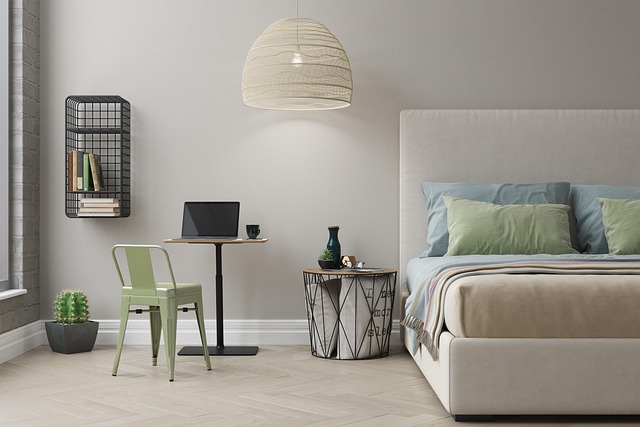Let me confess something upfront: my last bedroom looked like the inside of a kaleidoscope. I had tried to blend “boho” with “cottagecore” with “whatever was on sale at Target,” and what I got was chaos. A faux brick wallpaper peeling off in one corner, a rug that didn’t fit the room (but I convinced myself it “added movement”), and bedding that clashed with everything, including my mood.

© 2025 AI Illustrator — Inspiration Only
image by pixabay
I didn’t even know I needed a neutral bedroom until I hit my breaking point. It was 11:42 PM, I had stepped on a rogue incense stick, and I was trying to find my charging cable under a pile of decorative pillows that served no purpose other than to make me late for bed every night. That’s when I realized I didn’t want trendy. I wanted peace.
So, I started a slow, imperfect, semi-delusional journey toward a calm, neutral bedroom — and let me tell you, it changed my life more than green smoothies ever did.
The first thing I did? I painted over the chaos. I went with a warm greige (a word I made fun of for years) and instantly felt like I could breathe. Did I tape off the ceiling properly? No. Is there still a tiny streak of paint on the light switch? Absolutely. But wow — what a difference.
I didn’t have the money to go out and buy a brand-new bed, so I worked with what I had: an old IKEA frame that creaked like it had secrets. I threw a linen sheet over the headboard and pretended it was intentional. My partner asked if I was trying to start a ghost bed aesthetic. Rude, but fair.
Next came the bedding. I found a soft, cream-colored duvet cover on sale — and let me just say, trying to decipher the difference between “natural linen,” “stonewashed flax,” and “almond milk” in the bedding aisle should be an Olympic sport. I chose one purely because it was the last one left and had a tiny rip in the packaging. $18 win.
Lighting was another chaos zone. Our previous lamp had a flicker that felt like a horror movie clue. I replaced it with a ceramic thrift-store lamp that leans a little to one side but gives off the warmest glow. I also found a second one that almost matches — if you squint.
One night, I rolled up the rug and replaced it with a flatwoven beige number I found online for under $50. It doesn’t shed, it doesn’t slip, and it miraculously ties the room together. Our dog immediately claimed it as his nap zone, so now it has a bit more “texture,” but that’s real life, right?
Then came the curtains. I used to think curtains were just decorative — but the day we swapped out the dusty old blinds for long, flowing ivory drapes, the whole room softened. Even the sunlight looked prettier. I messed up the curtain rod placement the first time and had to patch the drywall (badly), but still worth it.
I started building little layers. A jute basket in the corner. A small bench at the foot of the bed that squeaks every time I sit on it. I added a diffuser that smells like eucalyptus and vanilla and now the room smells like a spa—or a really clean Pinterest board.
What I Tried That Didn’t Work
Look, not everything was sunshine and calm. For starters, I tried a “bright white” paint that looked like an interrogation room and made me question all my life choices. The throw pillows? Bought six different sets, kept one, and donated the rest — mostly because they made me sneeze or didn’t match my “calm” vibe.
I also overbought scented candles. I ended up with a mini shrine to “fall spice” that was more headache than hygge. Lesson learned: sometimes less really is more.
Oh, and I splurged on a super fluffy faux fur throw that looked amazing online but made me itch for days. Note to self: test before you invest.
My Bedside Table Essentials
If you peek at my nightstand, you won’t find a perfectly staged photo shoot. Instead, you’ll see a stack of dog-eared books (I’m halfway through three at once), a mug that always smells faintly of chamomile, and a little ceramic dish that collects all my random stuff — hair ties, a couple of mismatched earrings, and the occasional pen that I’m sure isn’t mine.
There’s also a tiny plant that somehow survived my black thumb (I think it’s a succulent?), and a bedside journal where I rant about the day or jot down ideas for my next decorating adventure.
It’s not glamorous, but it’s mine — a little messy, a little chaotic, and totally cozy.
If I Did It Again
Honestly? I’d take it slower. Instead of rushing to finish the whole room in a weekend, I’d spend months picking pieces that felt right, not just on sale.
I’d splurge more on the bed frame (because you spend a lot of time there), and less on trendy throw pillows.
And I’d hire someone to hang the curtains. That drywall patch is still a sore spot.
But most importantly, I’d remind myself that it’s okay if the room isn’t perfect. It’s supposed to be lived in — not a showroom.
Here’s what worked for me — not as a list, but as a messy collection of wins, fails, and real-life solutions:
I framed a page from an old poetry book instead of buying art. Hung it slightly crooked. Still love it.
We use a woven basket for all the things we don’t want to look at — laptop charger, random receipts, my one sock that always disappears.
I bought eucalyptus stems on a whim from the grocery store floral section, and three weeks later they’re still in a dusty vase. But they smell nice when I walk past.
My nightstand is an old side table with a weird burn mark on the corner. I covered it with a linen runner and now it feels “intentional.”
I don’t fold my throw blankets. I toss them over the chair like I’m in a Nancy Meyers movie. It’s a vibe.
I started using a white noise machine. Technically not decor, but game-changer.
We added a small floor mirror — nothing fancy, but it reflects the window light and tricks me into thinking the room is bigger. Sometimes I catch my reflection mid-yawn and scare myself, but still worth it.
I even hung a string of warm fairy lights behind the curtains. My partner rolled his eyes at first, but now he turns them on every night before bed.
There’s also a ceramic dish I use to collect all the random things I find in my pockets: earrings, bobby pins, a guitar pick I swear isn’t mine. It’s not a storage solution—it’s a habit now.
Final Thoughts
Creating a peaceful bedroom doesn’t mean it’s perfect. Mine still has a dent in the wall from when I tried to hang a mirror without help (bad idea). The drawer sticks. The curtain rod is slightly uneven. And there’s a laundry basket I pretend is modern sculpture.
But it feels like home. And more importantly, it feels like a place where I can just be — messy, sleepy, imperfect me.
So if your bedroom currently looks like a Pinterest board threw up, don’t panic. Start small. One wall. One lamp. One cozy texture at a time.
And remember: the most peaceful spaces aren’t the ones that look perfect. They’re the ones you actually want to be in at the end of a very long day.

